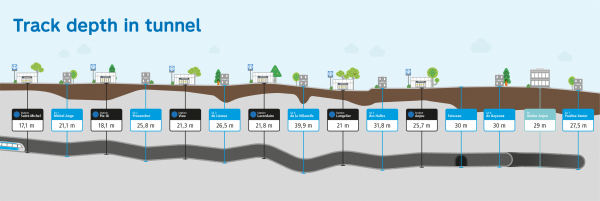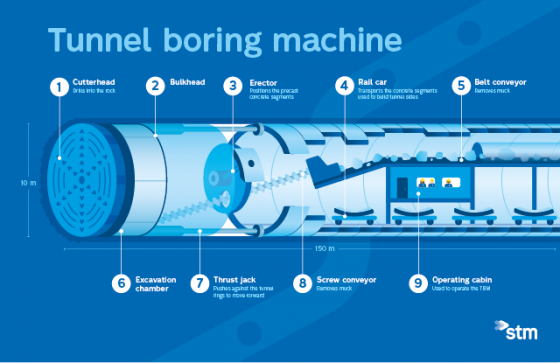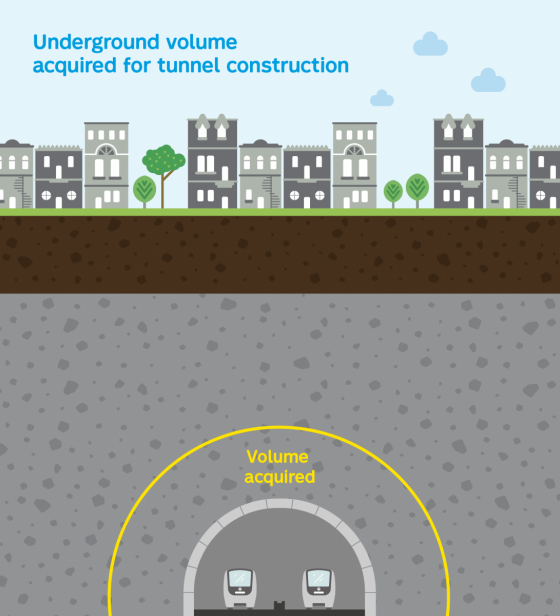A new option for your commute
Since July 7, the 814 Jean-Talon Est / Bélanger bus shuttle is in operation. This bus line runs between Viau Street and Langelier Boulevard. Check the Modifications to bus commute section to find out more about this new service in your area.
See the Latest Updates tab for information about the recent developments on Blue line project.
A large-scale project
Changing the face of mobility in the east end of Montréal
Because the Blue line project is taking shape in densely built neighbourhoods, the project office is intent on integrating it seamlessly into the living environments through which it will pass. There is a strong commitment to delivering a project that is up to the standards of residents and customers alike, and that will coexist positively with the community both while construction is underway and when the new infrastructures are in operation.
Here is a list of all the infrastructures that will be built east of Saint-Michel station:
- 5 new accessible métro stations
- about 6 kilometres of tunnel
- 2 bus terminals
- 1 underground pedestrian tunnel providing a link to the Pie-IX BRT
- Pedestrian walkway under Autoroute 25 in Anjou
- Several equipments and operational infrastructures:
- 7 auxiliary structures housing operational equipment
- 1 power station
- 1 service centre for infrastructure maintenance
- 1 métro garage

The Blue line project worksites
Public participation
let's chat
Public participation
Information sessions, talks, activities, good neighbour committees: our team wants to meet you!
Upcoming events
- July 23: information session for de Lisieux and de la Villanelle auxiliary buildings
- July 24: information booth at Le Boulevard shopping center
Latest Updates
Starting July 7 : 814 Jean-Talon Est / Bélanger bus shuttle in operation
Since construction on the Blue line extension began in the fall of 2024, lines 141 and 372 have been diverted onto Bélanger Street, where a reserved lane has been set up.
To improve service in the area and offer a local alternative on Jean-Talon East Street, the 814 Jean-Talon Est / Bélanger bus shuttle will enter into service on July 7.
This new line will operate 7 days a week, between 7 a.m. and 10 p.m., approximately every 30 minutes. It will run mainly on Jean-Talon East and Bélanger streets, between Viau and Langelier Boulevard. This line provides access to several areas along Jean-Talon Street, while taking into account road segments that have closed due to the construction work.
A new service added in your area
This new line is in addition to several other bus options available in the area during the Blue line extension work, including lines 32 Lacordaire, 33 Langelier, 95 Bélanger, 136 Viau, 141 Jean-Talon Est and 439 Express Pie-IX.
For more information, see the Modification to Bus Commute section
The five future stations now under construction
Only a few months after the first site was started, excavation is now underway at all the new Blue Line station sites. This is a pivotal step in project delivery which requires rigorous planning, specialized technical skills and the mobilization of many stakeholders.
Work is also underway at three sites where auxiliary buildings will stand, marking a concrete step forward in the field.
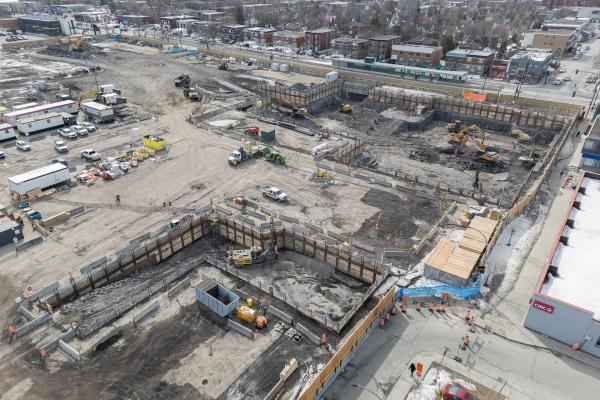
The Pie-IX construction site. Visible is the access to the underground tunnel that will connect the future station to the Pie-IX BRT.
An impressive step
Because Montreal’s subsurface is essentially made up of very hard limestone, excavation is particularly difficult and inevitably noisy, especially for the first few weeks, when operations are closer to the surface. Measures have been taken at each site to limit nuisances, including the installation of noise abatement walls with rock wool acoustic insulation, white noise back-up alarm systems on trucks, and excavation techniques that reduce the use of jackhammers.
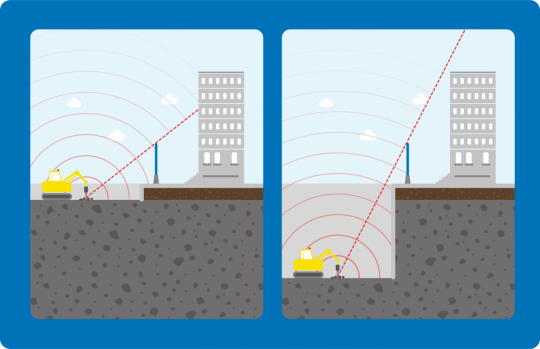
As excavation gets deeper, construction noise will be less noticeable on the surface.
Responsible management of excavated materials
Much of the rock extracted will be transported to the nearby Saint-Michel quarry. Saint-Michel quarry was chosen for strategic reasons—it’s a short trip for the trucks, which will reduce greenhouse gas emissions. It also leaves the rock near at hand so it can be reused for future municipal infrastructure projects to enhance sustainability.
We should also point that the work continues to be right on schedule. Other important milestones will be reached in the coming months, and we’ll provide regular updates as that happens.
Did you know...
The Blue Line extension tunnel will be nearly 8 km long, including the tail tracks and the underground train garage in Anjou. The depth of the tunnel will vary between 20 and 40 metres, depending on factors like the quality of the rock. Variations in depth are also designed into the route for efficiency purposes. The stations are usually shallower, to facilitate passenger access. That also provides for the train to be going uphill as it approaches a station, which helps it slow down and saves wear on the brakes. The train also gets a boost when it leaves the station, since it’s going downhill and needs less energy to speed up. Auxiliary buildings are located midway between the stations at greater depths where runoff tends to collect. They’re operational buildings with pumps to remove water from the network.
parlons·en
- Provencher auxiliary building: Consult the presentation and watch the recording of the event
- Michel-Ange auxiliary building: Consult the presentation and watch the recording of the event
- Controlled microblasting: Consult the presentation and watch the recording of the event
- Anjou sector : Consult the presentation and watch the recording of the event
- Lacordaire sector : Consult the presentation and watch the recording of the event
- Pie-IX sector : Consult the presentation and watch the recording of the event
- Viau sector : Consult the presentation and watch the recording of the event
- Langelier sector : Consult the presentation and watch the recording of the event
Start of microblasting excavation work
Microblasting excavation work will begin over the next few months on the Viau, Lacordaire and Langelier future stations sites and on the des Halles auxiliary building site. Consult the “Frequently asked questions - FAQ” tab for more information on this excavation method, or visit the page dedicated to each of these sites for information specific to your sector.
Previous news
Construction of the Provencher auxiliary building will start this spring.
Preparatory work will start as soon as the contractor opens the site in the week of April 14 and will last for about four weeks. The work will involve putting up noise walls around the site perimeter and preparing the ground for excavation.
Visit the Provencher auxiliary building construction page to learn more
A public information session held. See the “Parlons-en” box for more information.
The construction work to build the des Halles auxiliary building will start on April 22, 2025. The first four weeks will involve preparatory work. After that, the final worksite zone will be set up on the Halles d’Anjou parking lot.
Visit the des Halles auxiliary building construction page to learn more
Future Lacordaire station : Start of excavation work on February 3, 2025
The preparatory work announced in fall 2024 for the Lacordaire area is now completed.
All of this work had to be done before we can begin excavating the main project site for the construction of the new Lacordaire métro station.
The excavation phase started on February 3, and requires the full closure of a section of Jean-Talon Street, east of Lacordaire Boulevard.
Visit the Lacordaire station construction page to learn more
Viau and Langelier sites: Jean-Talon closed starting October 28
Work is going well at the Blue line project sites. Now that the preliminary work is done, we can set up the permanent worksite configuration and proceed with the excavation. This means that Jean-Talon Street will be closed to all traffic at the Viau and Langelier sites starting October 28, 2024.
- The Viau worksite will extend from De Cannes Street to west of Viau Boulevard.
- The Langelier worksite will be located just east of Langelier Boulevard.
- North-south traffic will keep running as usual on Viau and Langelier.
- Once Jean-Talon is fully closed on October 28, the bus stops for lines 141, 188 and 372 will be relocated to Bélanger Street. Visit the Modifications to bus service page for details.
- A reserved lane has been set up on Bélanger to keep buses running more regularly during the work.
- Roads will remain open to local traffic between worksites on Jean-Talon
- Local businesses are still open and accessible.
- Flaggers will be present at worksite entrances and exits for pedestrian safety.
- North/south transit lines will be maintained
- Access to homes will be maintained at all times
- Bus routes will be adjusted as needed, and a reserved lane for buses will be added on Bélanger
- Signage will be posted to direct pedestrians, cyclists and drivers
- Paratransit service will continue to operate on Jean-Talon
- The roads will remain like this for several years.
New reserved lane on Bélanger Street
A new reserved lane for buses, bikes and taxis will be introduced on Bélanger Street to improve traffic flow during Blue line extension work on Jean-Talon. Learn more about the modifications to bus commute.
- September 25, 2024 : We are kicking things off for the excavation at the site of the future Pie-IX* station. This work will result in the complete closure of rue Jean-Talon, east of boulevard Pie-IX.
- Towards the end of October 2024, other complete closures of Jean-Talon street will take place in the Viau and Langelier sectors.
- During 2025, other complete closures will be added on Jean-Talon street, notably in the Lacordaire sector. Partial road closures may also be required around the worksites.
This fall, construction will officially begin for the new stations in the Pie-IX, Viau and Langelier sectors. The work will involve full closures on Jean-Talon.
During the work - Good to know
- Roads will remain open to local traffic between worksites on Jean-Talon
- North/south transit lines will be maintained
- Access to homes and businesses will be maintained at all times
- Bus routes will be adjusted as needed, and a reserved lane for buses will be added on Bélanger
- Signage will be posted to direct pedestrians, cyclists and drivers
- Paratransit service will continue to operate on Jean-Talon
More full closures will be necessary on Jean-Talon in 2025, particularly in the Lacordaire area. There will also be partial closures in several areas.
Based on our current schedule, the initial excavation work on the Blue line extension will begin by the end of 2024.
The excavation will require a full closure of Jean-Talon Street. We’ll be able to provide more details about the worksites in the coming months. This will mostly be done through public information sessions.
More full closures will be necessary on Jean-Talon in the course of the coming year, particularly in the Lacordaire area. There will also be partial closures in several areas.
Good to know
- Bus routes will be adjusted as needed
- North/south transportation will be maintained across the worksites
- Access to businesses will be maintained at all times
- Roads will be open to local traffic between worksites
Several lots were purchased to build the future stations and infrastructure of the Blue line extension. Over the next few months, several buildings will be dismantled to secure the sites and prepare them for subsequent excavation.
The following will be dismantled over the coming months:
- Two commercial buildings at Galeries d’Anjou, between Des Roseraies and Louis-H.-La Fontaine.
- Two commercial buildings located East of highway 25, at the corner of Châteauneuf and Louis-H.-La Fontaine.
- Former gas station building at the corner of Jean-Talon and Langelier.
- West side of the commercial building on Jean-Talon, at the corner of De la Villanelle. Only the portion currently occupied by the convenience store will be removed. Nearby businesses will remain open.
- West side of Le Boulevard shopping centre. The shopping centre will remain open during the dismantling.
Boots on the ground
Our accomplishments to date are a tangible sign of the project’s progress. The preparatory work that we have carried out in recent months includes moving underground infrastructure out of the way of the excavation sites for the future Langelier and Viau métro stations.
Geotechnical borings were also conducted at several locations to characterize the rock in the area where the new infrastructure will be built.
In addition, we demolished several buildings to make way for the new stations and operational infrastructure. The buildings were carefully dismantled, and their components were gradually sorted for recycling.
Community first
This year, the Blue line project team met with the public on several occasions. Our experts attended several conferences and held information sessions and good neighbour committee meetings to explain the work ahead and address people’s concerns.

Photo: Olivier Bousquet
Have you noticed the bright colours decorating the street at the corner of Jean-Talon and Lacordaire?
With the help of municipal funding, the Société de développement commercial de la rue Jean-Talon Est (SDC) teamed up with local arts organization MU to create a new piece of public art on an STM-owned building on Jean-Talon, breathing new life into the street.
Ready for worksites in 2024
There is no doubt that 2024 will be an important year. The stations’ architecture will be revealed, and major construction will begin. By the end of the winter, more buildings will be demolished to make way for future infrastructure that will benefit the entire community.
Preparatory work and building demolitions
Preparatory work in the Viau area is progressing as planned. In late May, work will end in some areas, freeing up more street parking. The work should be completed in fall 2023.
In late June, preparatory work will begin in the Langelier area. This will continue until the fall and require street closures at the intersection of Jean-Talon and Langelier. The work will be carried out in phases to reduce the impact on your travel.
We have also finished demolishing several buildings to make way for new stations and operational infrastructure. In a few weeks, we will also remove the buildings located at the site of the secondary entrance building of the future Pie-IX station. Once these sites have been secured, we will be completely ready to begin the excavation in 2024.
Le Boulevard shopping centre redesign project
In the next few months, measures will be implemented to ensure harmonious coexistence between Le Boulevard shopping centre and the future Blue line project worksite. Sections of the parking lot on the south and east sides of the building will be refurbished, including the area that was used as a snow disposal site last winter.
February 2023 – On track to completion
New year—lots of new plans! Find out what’s happening east of Saint-Michel station.
Public art beautifying the Blue line project
A few weeks ago, we revealed the five artists selected to make our new stations a visual delight for our customers. Do you know who they are? You can read more about each artist’s background and vision on the architecture and artworks tab of this page.
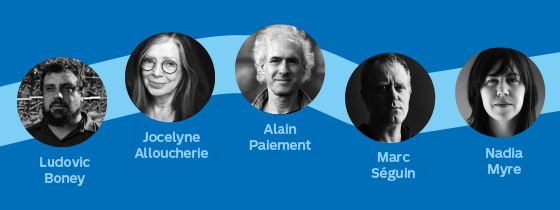
A major technological shift
In January, we launched a call for tenders for a complex and crucial project: the deployment of a new train control system on the Blue line and its future extension. Learn more about this cutting-edge technology and how it will change your transit experience for the better.
Preparatory work and building demolitions
Preparatory work in the Viau area has been on break for the winter and will resume in March with excavation on Baunard Street. Then, in early summer, more digging will be done in the Langelier area. The work will serve to relocate underground utilities (water pipes, sewers and cabling) to prepare the sites for the construction of future stations.
At the same time, we will be demolishing several buildings to make way for new stations and operational infrastructure. By the summer, the landscape will be quite different in the areas of Viau and Lacordaire, followed by Saint-Michel and Pie-IX (secondary entrance building). Once these sites have been secured, we will be completely ready to excavate!
Following efforts to optimize the Blue line extension, the locations of certain operational infrastructure have changed. The Anjou terminal station will have two entrance buildings to serve the areas located west and east of Highway 25. We reviewed the locations of the infrastructure needed to operate the métro in Anjou and created a final plan after studying several scenarios with the project partners.

Work in Anjou is currently expected to begin in 2024. Traditional excavation methods will be used east of Highway 25, as the tunnel boring machine will exit the ground west of the highway. Between now and the start of the work, surveys or drilling could be required to help engineers complete the plans and specifications. This work would be occasional and not very disruptive.
This month, we will begin preparatory work for the construction of the future Viau station. The work will first take place mainly on Viau Boulevard, where teams will demolish the central median. Then, all southbound lanes will be closed between Jean-Talon and De Paisley streets. Between now and fall 2023, this major work will allow us to relocate underground utilities (water, sewage and cabling) out of the way of the future station excavation site.
For full information on this worksite, check the web page for the future Viau station.
This is a first for the Montréal métro network. This construction method gets the work done faster, provides longer-lasting results and is better for the environment.
In due time, you will be invited to help us choose a name for the tunnel borer by voting on suggestions from our employees.
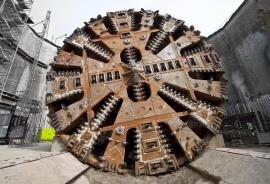
The cutterhead grinds away the bedrock
Following the expert committee’s work to optimize the project budget, some parameters have been revised.
Key details:
- Construction of all five new universally accessible stations up to Anjou as planned
- Reconfiguration of the Pie-IX station bus terminal
- Removal of lower-traffic secondary entrance buildings (Viau and Langelier)
- Sharing of the planned secondary entrance building at Lacordaire station with CDPQ Infra to be integrated with the REM de l’Est.
- Repositioning of the Anjou station with entrance buildings on each side of Highway 25.
- Removal of park-and-ride lot in the Anjou area
- Use of a tunnel boring machine to build the tunnel
Next steps:
- Preparatory work in the Viau area in summer 2022
- Commissioning of the extension in 2029
In the spirit of agility and collaboration, every effort has been made to make this project the best that it can be and to bring us closer to this long-awaited asset for the east end of Montréal.
The STM is now the owner of Le Boulevard shopping centre, having completed the expropriation process started earlier in the project timeline. The mall will be able to remain in operation during the expected construction period of the new Pie-IX station.
This month, the second preparatory worksite for the extension of the Blue line will get up and running at the intersection of Jean-Talon Street and Lacordaire Boulevard. Between now and the spring of 2022, this major work will make it possible to relocate underground utilities (water, sewage and cabling) out of the way of the future station excavation site. Two other locations, namely Viau and Langelier, will undergo similar work later this year.
To learn all the details on this worksite, check the web page of the future Lacordaire station.
The chosen station names will go down in history as a mark of Montrealers’ collective imagination. They should be announced later this year.
The naming committee is composed of several STM representatives, a City of Montréal elected official, representatives from boroughs where the extension is being built and experts in place naming and urban planning. Montréal’s women, cultural communities and Indigenous peoples are also represented on the committee, and proposals from these groups will be given particular consideration.
The beginning of this process marks one more step toward the project’s completion!
In February and March, a public consultation process took place in the form of several information evenings and input sessions. The goal of this community dialogue was to design a project that would integrate seamlessly into the lives of Montrealers.
The Commission leading this process has submitted its report and issued 43 recommendations that will allow us to enrich the project and produce infrastructure that meets the expectations of our customers and citizens. Both the Commission’s report and the STM’s action plan in response to it are available at www.stm.info/consultation.
There’s no doubt about it—the Blue line project is right on track!
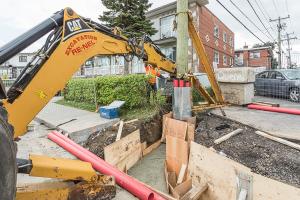
This is it!
This fall, we will begin preparatory work for the Blue line extension in the area around the future de la Villanelle auxiliary structure. This marks an important milestone in the project’s progress.
The work will mainly involve relocating urban public utilities, giving us free rein to begin the massive excavation that will be needed to build the new infrastructure.
Other target areas
In the next few months, we will also begin work in three other locations, near the future Viau, Lacordaire and Langelier stations. Information on these worksites will be available a few weeks before the start of the work.
The information evenings and input sessions are now closed. We would like to thank you warmly for your relevant and useful comments. This dialogue with the community is essential to helping us design a project that will integrate seamlessly into the lives of Montrealers.
The Commission’s report will be available at stm.info/consultation this summer.
Two new teams of architects have started working on the drawings for the buildings of the future Viau and Lacordaire stations. These complete the design brigade which started work at the end of 2019. An initial draft of the architectural design of these stations will be presented to the public in spring 2020.
Teams of architects have started working on the drawings for the buildings of the future Pie-IX, Langelier and Anjou stations. By the end of the year, two other groups of architects will join the design team and create Viau and Lacordaire stations. An initial draft of the architectural design of these stations will be presented to the public in spring 2020.
In addition to conducting ongoing above-ground seismic surveys and boring tests all along the Blue line extension route, we are collecting geotechnical data at Saint-Michel station.
Our teams will be conducting surveying work on the Saint-Michel tail tracks to gather highly detailed data on the existing tunnel and plan the connection to the new extented tunnel. As the heat released by the trains stationed on the tail tracks interferes with the accuracy of the laser instruments used for surveying, we will have to close the tail tracks on September 21 and 22.
Minor impact on your trips at this station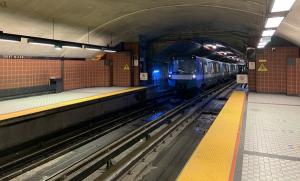
As trains will not be able to pull onto the tail tracks to turn around, customers going toward Snowdon will exceptionnally have to board on the exit platform. The train will then switch tracks when it departs toward Snowdon.
As part of the input data collection, geotechnical tests have begun along the corridor between Saint-Michel métro station and Highway 25 in Anjou.
The purpose of the tests is to classify soil and rock in the selected area in preparation for the construction of the underground tunnel and stations. The tests comprise two major phases, namely seismic surveys and boring tests.
1. Seismic surveys involve sending waves into the ground along a conducting wire connected to sensors. This non-intrusive, quick, one-time method limits the number of boring tests required for classification that will be conducted in a second phase of exploratory work.
2. Boring tests allow us to obtain more detailed data on soil and rock conditions, such as their resistance and profile. These characteristics serve as input data for the engineers who will design the plans and specifications.
The location where the tests are performed does not necessarily correspond to the locations of future métro stations or tunnels.

The current test involves extending lines over 40 to 70 metres, with sensors installed every 3 metres.
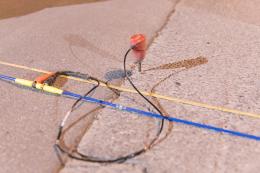
The cable is equipped with sensors that act as refraction wave receivers. The sensors are connected to the seismic line and slightly inserted into the ground or the road along the entire line.
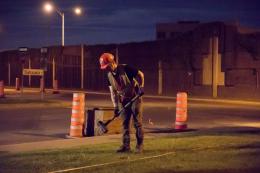
The waves are sent into the ground every 10 metres by manually striking a 20-lb. (9-kg) sledgehammer against a steel plate on the ground. The plate and sledgehammer are connected to the seismic cable, sensors and receivers. The plate is struck several times to ensure that the waves are effectively transmitted all along the seismic line.
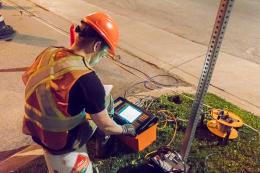
The geophysical technician measures the wave refraction data directly on site and ensures that the signals are clear. Subsequent interpretation of the data will help identify the characteristics of the rock.
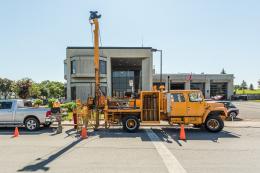
A drilling rig is used to extract rock cores up to 60 metres underground, below tunnel level.
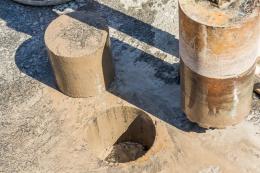
First, the road is cored for boring to take place. The operation is repeated at regular intervals along the six-kilometre route. The area will be restored after the tests have been completed.
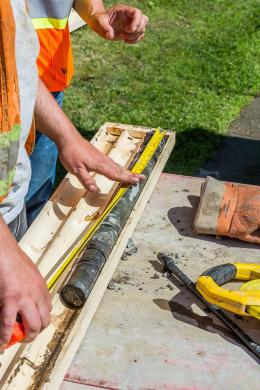
Samples are taken either vertically or diagonally from the soil and rock, depending on the data sought by the geologists.
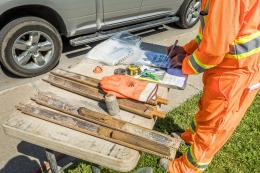
The soil samples collected are then analyzed in a laboratory to identify their properties and characteristics.
Blue line project press room
Architecture
Architectural direction of the project
The Montréal métro is known around the world for the diversity of its stations. Each station is the outcome of a unique architectural design. This was how the original network was designed, and the Blue line project will be no exception.
A thorough selection process was carried out to mandate specialized and recognized architecture firms to design the buildings. Beyond meeting the functional and safety requirements of a métro station, the architectural design plays a role in creating harmonious, attractive and sustainable environments.
In addition to the five new stations, seven auxiliary structures must be built to support network operations. Architecturally, the structures will be developed with as much care as the stations themselves. An integrated strategic thinking process, a heritage analysis, and study of the urban fabric will ensure optimal integration of these structures into their surroundings.
The architectural directions for all buildings will be announced to the public in 2025.
Artworks
The value of art
A process was carried out with the Ministère de la Culture et des Communications to identify five artists whose work would enrich the environment and customer experience of each of the new stations. The selected artists will work in collaboration with the architects to ensure that their work fits harmoniously into the new stations.
Here are the artists who will create unique artworks for each of the five stations of the extension.
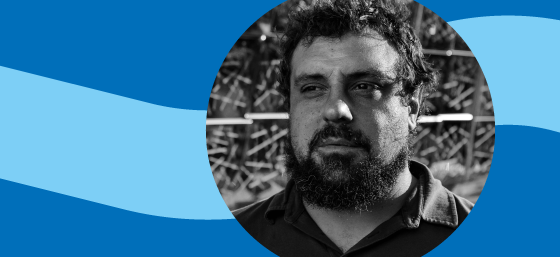
Born in 1981 in the Huron-Wendat community of Wendake, near Quebec City, Ludovic Boney was raised and went to school in the province’s capital. The artist has long been drawn to public art, namely “art that is accessible to the users of our parks, streets and cities.” Since 2015, he has been based in Lévis, where he works on large-scale public art projects and regularly exhibits his work in galleries and artist-run centres.
His artistic approach is often inspired by places and their prevailing atmosphere. For the future Pie-IX station, he will create a colourful piece that will be embedded into the structure of the walls. This is an uncommon practice in the public art world, and it will have its fair share of challenges. But for Boney, obstacles of this kind fuel his work. The Pie-IX station project is a dream come true for him: “This is a unique opportunity, since artists don’t usually have any say on the space intended for the work. In some cases, the building has already been completed and delivered. With this piece, I’ll be working with architects to create an artwork that will be integrated fully into the station.”
The artwork will reveal itself differently to passersby, depending on the lighting and their movements, allowing them to discover the work’s many subtleties.
Recent works of the artist
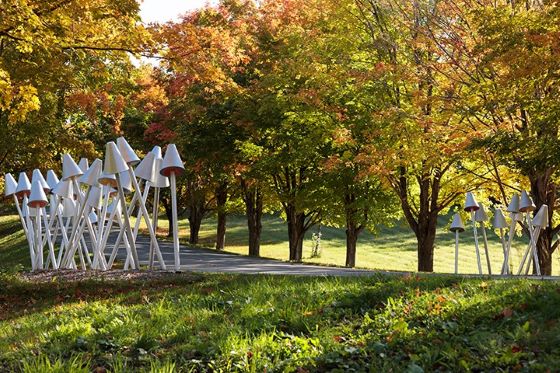
Sous l'oeil des spectateurs, Parc de la Rivière-Etchemin / Ville de Lévis
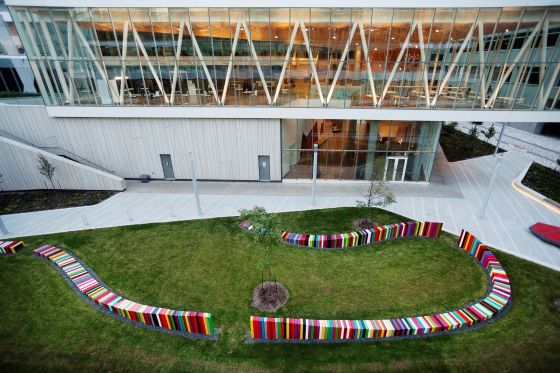
Réaction en chaîne, École de technologie supérieure
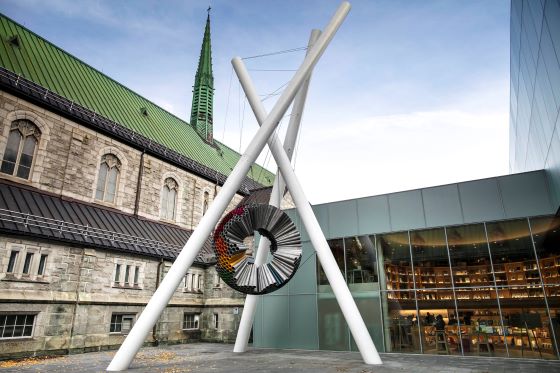
Une Cosmologie sans genèse, Musée national des beaux-arts
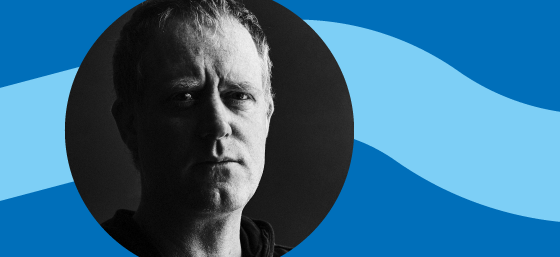
Marc Séguin was born in Ottawa in 1970. He received his BFA from Concordia University, where he studied under Guido Molinari. He currently lives and works in Montréal. Already in 1996, his first solo exhibition featured large-scale paintings with astonishing plastic features. He is also the author of several novels.
For the future Langelier station, Séguin will create a hand-painted cyclorama with a narrative framework. The piece will be over 100 metres long, which will make its integration into the station a major task. However, the artist, working in synergy with the architects, has already started thinking about possible strategies.
For Séguin, public art allows him to connect with customers and citizens and bring art into their lives. By creating this work of fine art, the likes of which exist almost nowhere else in métro systems worldwide, the artist is fulfilling a long-held dream: “It’s a privilege to have access to the public in an urban setting. People will live with the work. They will see a part of it in the morning, and another part in the evening coming back the other way. There’s a very interesting and inspiring immersive quality to it.”
Recent work of the artist
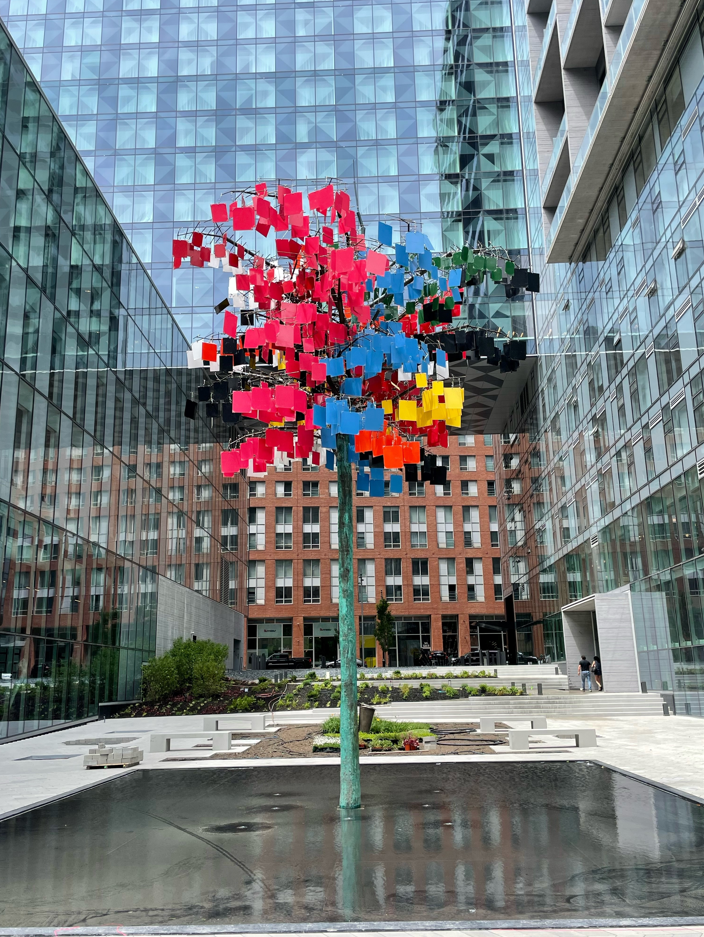
Anima
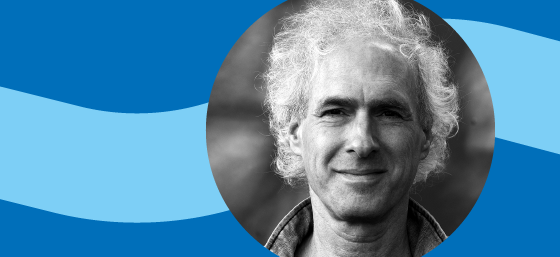
Alain Paiement was born in Montréal in 1960, where he currently lives and works, having spent over a decade in Europe. He is an adjunct professor at the École des arts visuels et médiatiques of the Université du Québec à Montréal. His practice has spanned painting, installation, photography and video, with an ongoing interest in geography and mapping processes.
The artist is delighted to create a project for the métro: “As a child, when taking the métro, I saw the artworks in each station, and I thought that one day I’d like to make one.”
Paiement is interested in public art because it is accessible to all and lets him reach people outside a designated cultural framework. For the Montréal métro, he will create a bright high-rise piece that will be integrated into the station. It will shift as natural light passes through it.
For him, art is a vehicle for interrelation. He aims to represent the multiplicity of cultures through the use of various forms and textures. Métro customers will be able to discover—and rediscover—the work during their visits, as the shapes and patterns will vary, appearing differently depending on their location in the station and the time of day.
Recent works of the artist
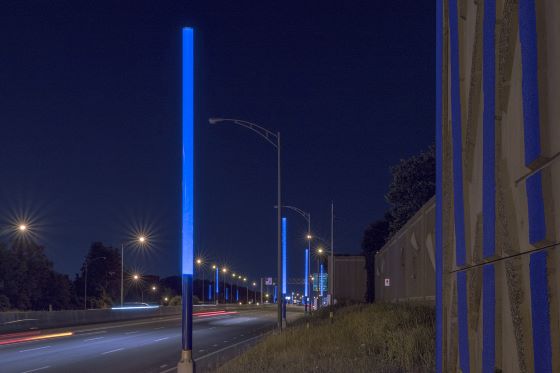
Bleu de bleu
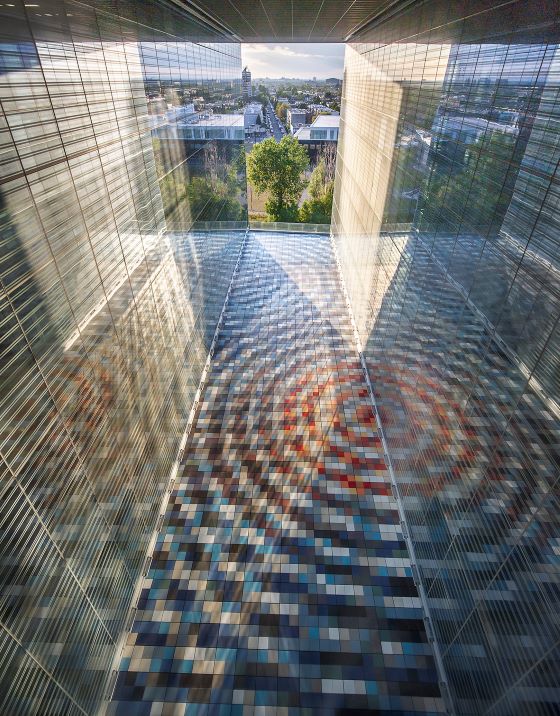
Ondes croisées
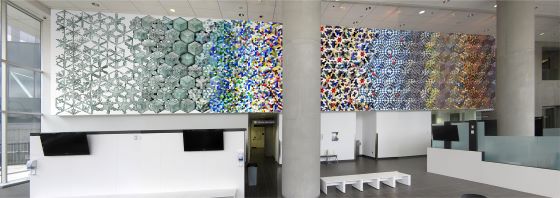
Tessellations sans fin

Jocelyne Alloucherie lives and works in Montréal. Through complex configurations, her work explores conceptual and poetic notions of images, objects and places. Her work can be found in many art centres and galleries in New York and Montréal, but also across Canada, France, Italy and Spain, to name a few. She was appointed to the Order of Canada in 2008.
For the future Viau station, she aims to create a clear, open piece, that lets everyone feel engaged in their own way. It will be integrated harmoniously with the unique architecture of the station.
Alloucherie’s artistic approach also draws on the concept of a journey. Conscious that métro customers are always walking and on the go, she wants the artwork to provide them with special moments as they pass through the station.
The artist will use photography as a starting point for her work, but the images will be reworked to evoke landscapes that do not belong to any specific place and that are open to interpretation.
Recent works of the artist
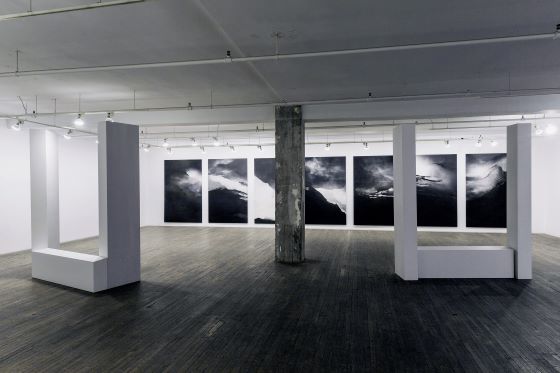
Terre de sable

Regarder les pommetiers
To learn more about the artist, visit jocelynealloucherie.com
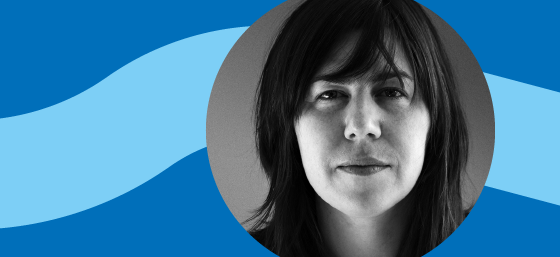
Born in 1974 in Montréal, Nadia Myre is an Indigenous visual artist from Quebec. Her practice has been inspired by participant involvement to initiate dialogues on identity, resilience and politics of belonging. She has received many awards, and her work can be found in the permanent exhibitions of several museums. Myre is also the Canada Research Chair in Indigenous Arts Practice.
Her art focuses on the point of contact between different cultures and on indigenousness. The métro is a strong cultural symbol. By creating a piece for the future Anjou station, she aims to express the complexity of the multicultural social fabric of Montréal.
For this piece, Myre draws her inspiration from the history of the place, people of the neighbourhood, and symbols—both individual and collective: “I’m interested in symbols that are repeated from one person to another, no matter where they are in the world. Symbols can be a language of universality.”
The artist has done extensive research on weaving and beading on large surfaces. In the coming months, we will learn more about her plans for the artwork and its integration into the station’s architecture.
Recent works of the artist
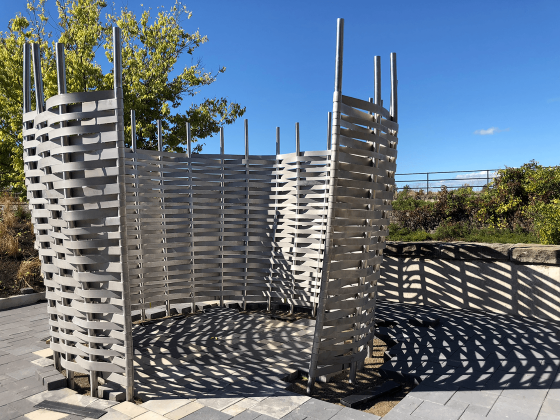
Pimisi Station

Dans l'attente
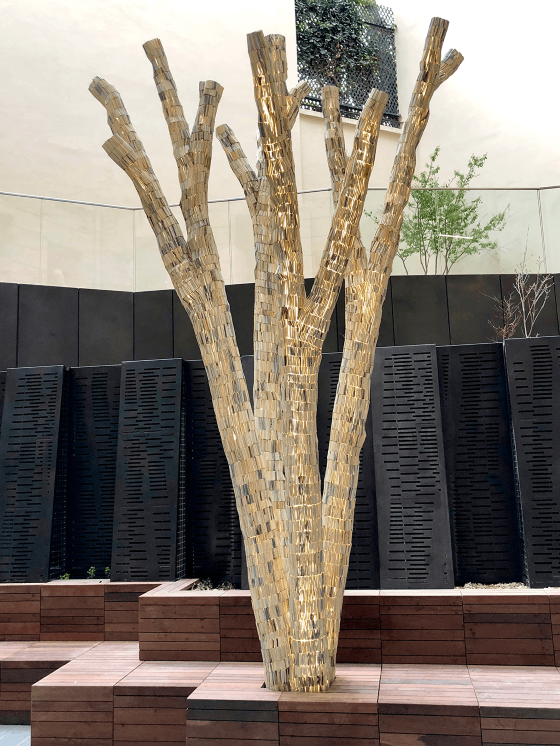
Tree of Shifting Forms
Incorporating artworks into the network is a core value and adds to the distinctive identity of the Montréal métro.
Since the late 1970s, any building or extension of a public building financed by the Quebec government must include an artwork by a Quebec artist, valued at roughly 1% of the construction budget. As such, each new station on the Blue line will include an original Quebec artwork.
To be considered, artists had to be registered in the Ministère de la Culture et des Communications artist database. A committee created by the Ministry first narrowed down the list of more than 600 applicants to 20 names. These artists were then asked to submit a proposal outlining their artistic vision for the new stations, remaining anonymous in the process. For each station, the jury, which included the station’s design architect, selected one artist.
Montrealers already know that every station in the Montreal métro is unique. But did you know that it is a global trailblazer in terms of integrating artworks in its stations? Since its opening, the network has had a long tradition of inviting artists to work with design architects to create artworks that reflect the identities of the stations, making our network a true underground museum!
According to Art Public Montréal, public art “refers to all works of art in public spaces, whether outdoors or indoors. The works are permanent and installed in common public areas. Public artworks are presented in more or less discreet ways, affirming their formal, conceptual or temporal characteristics. They can relate or not to their site, adapt harmoniously to their environment or contrast with it, depending on the artist’s intention.”
Toponymy
The process to select the names of the five future stations is in progress. In 2021, a naming committee was formed, made up of elected officials, borough representatives, specialists in history, toponymy and urban planning, and cultural group representatives. They recommended a few options for each station. The selection criteria reflected the recommendations made by the commissioners following the public consultation held in winter 2020. In analyzing the name proposals, the committee decided to prioritize women and set an intention to ensure that the final choices represent multicultural and Indigenous realities.
The naming process for the new stations is underway, and we are working with the Commission de toponymie, the City of Montréal and other project partners. We must also contact the relevant families before we can announce the names of the stations publicly. We hope to share the names in 2025.
Frequently asked questions
Controlled microblasting
Controlled microblasting is already used on several major STM worksites, depending on the type of rock to be excavated.
It’s safe, much faster and more effective than mechanical methods, and reduces neighbourhood disturbances, making it an excellent solution for densely built environments.
Watch this short video to learn more about controlled microblasting in urban environments
Video in French, English subtitles available
Given the composition of the rock to be excavated along the extended métro line, controlled microblasting is much faster and more effective than mechanical methods. The alternative to microblasting would be to use hydraulic jackhammers to break up the rock, which would be noisier and take much longer.
Controlled microblasting limits neighbourhood disturbances when excavation work is needed.
Controlled microblasting is a safe blasting technique that uses low-volume, individually triggered blasts. We use reduced charges to limit vibrations, noise and possible rock fragment projectiles, or fly-rock.
Each low-volume blast lasts 0.3 to 0.5 seconds. During this short period, a series of small, calculated explosive charges are triggered.
Strict vibration standards must be met for all above-ground buildings, as well as underground infrastructure such as sewers.
Each type of structure is classified according to specific criteria that determine the maximum vibration threshold to be met. This threshold has a very high safety margin compared to the minimum vibrations that would potentially cause cosmetic damage to the structure.
For each blast, qualified engineers calculate the estimated vibrations to ensure that vibration thresholds are met.
During the blast, seismographs installed near the buildings closest to the blast are used to measure the vibrations.
This data is then transmitted to the engineers so that they can calibrate and refine their calculation model. The data collected allows them to ensure the blast was compliant, make any necessary adjustments, and achieve even greater precision in planning the next blast.
All buildings located within a 75 m radius of excavation faces will be inspected by an independent, specialized firm. This procedure is a common precaution aimed at protecting building owners in the very unlikely event their building suffers any damage. The data collected on the condition of buildings also allows us to better plan blasts, based on the environment.
To ensure full control of each microblast, only the latest-generation cartridge explosives will be used. No bulk explosives are authorized. The aim is to make sure that for each microdetonation, the blasting team has full control of the explosive charge at all times. It also allows the team to avoid any loss of product in the rock fissures during loading.
To trigger the cartridge explosives, the blasting team uses programmable electronic detonators. These high-precision products allow for optimal vibration control and allow the team to check the entire firing circuit prior to blasting.
It’s also important to note that no explosives are stored at the worksite. Any excess charges are safely transported off site and properly stored.
Each blast is completely covered with blasting mats made of recycled tires.
A double or even triple thickness of blasting mats is placed directly on top of the blast. The mats are so heavy that hydraulic shovels have to be used to put them in place.
The blasting mats are removed immediately following the blast so that the excavation team can start excavating the blasted rock.
In addition to controlling fly-rock, the blasting mats dampen the noise from the blast and control dust.
To minimize the risk of emissions, we only use explosives that generate the least possible amount of blasting fumes. There are also very rigorous provincial standards that must be met for each blast. That includes giving each resident within a 100‑m radius of the blasting area a carbon monoxide detector to install in their basement.
Project planning
At this stage, based on the information that we have and the scenarios that are possible, we should be able to open the Blue line extension in 2031. Due to operational constraints, the five new stations will all have to be opened at the same time.
The STM will act as the principal contractor and project manager. As operator of the Montréal métro for the past 50 years, the STM has expertise and experience that will benefit the project.
These decisions were made by the métro extension project office, made up of the Agence métropolitaine de transport (AMT) and the Ministère des Transports du Québec (MTQ), from 2011 to 2015. Their analyses led to the finalized design plan regarding:
- Route
- Locations of entrance buildings
- Bus terminals
- Park-and-ride lot
They used a method called multidisciplinary analysis (MDA), allowing them to examine the pros, cons and limitations of each option, from the perspective of each of the following disciplines:
- Métro operations
- Public transit and station access
- Urban integration and environment
- Work impact management
- Urban development
- Finance
- Socio-politics
- Constructability
These in-depth analyses brought together the various stakeholders (the MTQ, the AMT, the City of Montréal and its relevant boroughs, and the STM) to finalize the design plan that we have today.
For more information and to see the benefits of the chosen options, see our summary (french only).
In line with our commitment to integrate sustainability best practices, we are seeking Envision verification for this project. The Envision reference framework was developed to cover all the sustainable development aspects of an infrastructure project and each phase of its life cycle (planning, design, construction, operations and maintenance, and end-of-life). It is the top sustainable development tool in North America for major infrastructure projects such as metro and streetcar systems.
Verifying the project will allow us to:
Consult and involve stakeholders
Mitigate construction impacts on our community and environment
Reduce the impacts of materials used (resource consumption and manufacturing emissions)
Rehabilitate contaminated land
Reduce operational impacts (residual materials, water and energy savings, noise and vibration reduction, etc.)
Improve vegetation cover
Improve the project’s resilience to climate change
To learn more, visit the Institute for Sustainable Infrastructure Website.
In February and March 2020, a public consultation process took place in the form of several information evenings and input sessions. The goal of this community dialogue was to design a project that would integrate seamlessly into the lives of Montrealers.
The Commission leading this process has submitted its report and issued 43 recommendations that will allow us to enrich the project and produce infrastructure that meets the expectations of our customers and citizens. Read the report and the action plan.
Azur trains will run on the entire Blue line as soon as the five new stations are commissioned. We must replace the train control system on the current Blue line to ensure that it matches the new technology that will be used on the extension. This is because MR-73 trains are not compatible with the new equipment.
Additionally, since Azur trains must have nine cars, we will redesign the platforms at Saint-Michel station to ensure that they are long enough to accommodate these trains.
Yes, the new stations will be universally accessible and consequently equipped with elevators.
The five new stations will be designed so that platform-edge doors could be installed in the future. However, this will not be done as part of this project.
Progresse updates
To prepare for upcoming excavation work, the STM has tasked an independent firm with inspecting buildings that meet at least one of the following criteria:
- Located within 75 metres of any surface-level excavation work
- Located within 30 metres of the tunnel axis
The inspections will be conducted by ABS and serve to compile an inventory of the structures surrounding the worksites for the Blue line extension. The findings of the inspections will also be used to establish the maximum vibration levels for each site. Although these inspections are a precautionary measure, they are essential in the unlikely event that the work causes any damage.
As a further precaution, any building within 100 metres of a worksite where there will be microblasting will receive a carbon monoxide detector a few weeks before the excavation work starts.
Each building inspection lasts approximately 15 to 30 minutes. Photos are taken of the building interior and exterior. The photos are mostly close-ups of the foundations, walls, ceilings, and floors and serve to document the building’s condition prior to the start of the excavation work.
The pre-construction inspection is a common precautionary measure for major construction sites. It protects you in the unlikely event that your property suffers any damage during work on the Blue line extension.
Yes. This is a first for the Montréal métro network. A tunnel boring machine (TBM) is a piece of equipment that digs and builds underground structures. More specifically, it is a massive rotating drill designed to dig and apply concrete in circular tunnels, galleries and shafts.
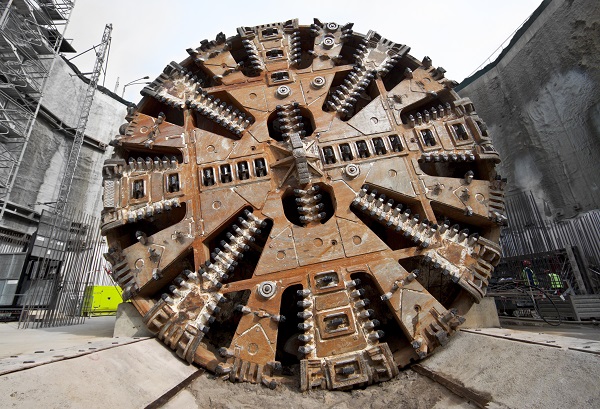
The cutterhead grinds away the bedrock. This construction method gets the work done faster, provides longer-lasting results and is better for the environment. The TBM also has the advantage of being less noticeable to residents than traditional excavation methods, such as cutting machines and blasting, since it generates less noise and vibration.
In due time, you will be invited to help us choose a name for the tunnel borer by voting on suggestions from our employees.
Yes, the law stipulates that the STM must own the underground volume and hold a legal easement when building a tunnel related to a transportation infrastructure project, in this case the BLE.
To do this, we notify the owners and right holders of the lots affected by the work. These owners and right holders are notified by means of a letter delivered by a bailiff.
The tunnel will be located at a depth of between 18 and 40 metres underground. The following infographic provides a better understanding of the volume acquired underground.
With a project this big, some traffic disruptions are unavoidable. Full and partial street closures are planned at various points along the route, some lasting up to several years. Most will be near the sites of the new métro stations and service buildings.
Good to know
- Roads remain open to local traffic between worksites on Jean-Talon
- North/south transit lines are maintained
- Access to homes and businesses is maintained at all times
- Bus routes have been adjusted, and a reserved lane for buses was added on Bélanger
- Signage is posted to direct pedestrians, cyclists and drivers
- Paratransit service continue to operate on Jean-Talon
The Blue line extension work starting in fall 2024 will require full and partial street closures on parts of Jean-Talon. As a result, the 141 and 188 will be rerouted to Bélanger Street, where a new reserved lane will be in effect to keep bus service efficient and reliable during the work.
The 95 Bélanger and 811 Navette service santé Shuttle will keep their regular routes on Bélanger and will therefore also benefit from the new reserved lane.
When work begins on the Blue line extension, the 141 will take the following detours :
Eastbound : buses will be rerouted onto Bélanger Street, between 19th Avenue and des Halles Street.
Westbound : buses will be rerouted onto Bélanger Street between des Halles Street and 30th Avenue, then onto Provencher/Everett streets until 19th Avenue.
When work begins on the Blue line extension, the 188 will take the following detours :
Eastbound : buses will be rerouted onto Bélanger Street between 19th Avenue and Viau Street.
Westbound : buses will be rerouted onto Bélanger Street between Viau Street and 30th Avenue, then to Provencher/Everett streets until 19th Avenue.
The work schedule will be planned according to the overall project schedule. Due to the scale and complexity of the worksites, the three boroughs involved have worked together to align their respective by‑laws. This will help us keep the total project duration to a minimum.
For example, since the TBM is such an important project component, it’s going to be in operation 24 hours a day, 7 days a week. The noise levels allowed will vary depending on the time of day, the type of working being done, and neighbourhood composition. Mitigation measures will be in place at all times to reduce disturbances, and noise levels will be monitored continuously.
Most of the rock excavated for the new infrastructure will go to the Saint Michel quarry. The city will then be able to reuse it for municipal projects, since the rock will be clean and safe.
Trucks will start taking the rock away in winter 2025. There will be a few dozen trucks a day for about three years. This will happen mostly during the day, but some truckloads may have to go out at night. All rock transportation will be done in compliance with municipal by-laws, and mitigation measures will be taken to limit the impact on the neighbourhood.
.
In the fall of 2024 and 2025, urban forestry work will take place around the Blue line project worksites. Trees that interfere with the construction sites will be protected, replanted, or cut down. Our team of forest engineers, landscape architects, urban planners, and sustainable development experts has carefully planned these interventions to preserve as many trees as possible.
The goal is to replant the trees wherever possible. Soverdi, the not-for-profit organization overseeing the replanting process, will monitor and care for the trees after they are transplanted to ensure their survival. Trees that can’t be replanted due to their size or condition will be recycled into wood chips, firewood or compost depending on the quality of the wood. The health and species of the trees will also help determine which ones need to be cut down, based on whether they are diseased, subject to borer infestations, or invasive, among other factors.
Ultimately, Blue line project sites will be revegetated and several hundred new trees planted, for a stronger, healthier canopy. For every tree replanted or cut down, we will plant more than two in their place.
No, that is not part of the plan.
With the acquisition of the AZUR métro cars and the construction of the Côte-Vertu garage, there will be an increase in the service offer on the Orange line in terms of capacity and frequency. The interval between trains on the Orange line will be two minutes instead of two minutes and 30 seconds during peak periods. Additionally, other major projects should mitigate the impact for Orange line users:
- The Pie-IX BRT, when completed, should provide a connection between the extension of the Blue line and the Green line.
- A connection with the REM is planned for Édouard-Montpetit station to ensure a link with downtown.
The projet in images
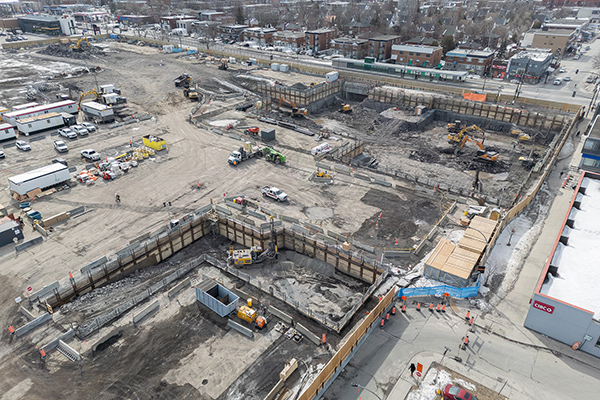
Construction site of the future Pie-IX station (working name) in March 2025
Construction site of the future Lacordaire station (working name) in March 2025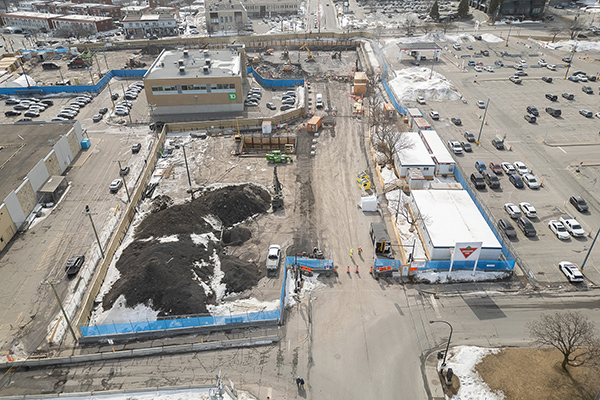
Construction site of the future Langelier station (working name) in March 2025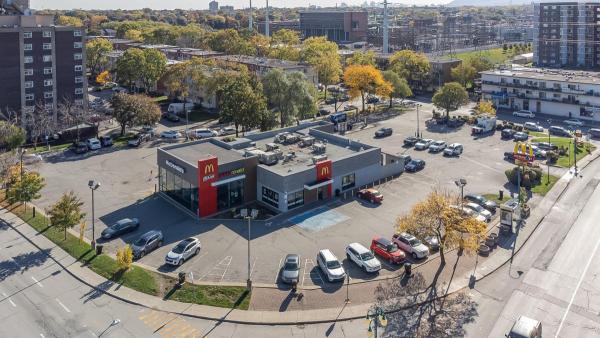
Site of the future Viau station (working name) at the corner of Jean-Talon and Viau Boulevard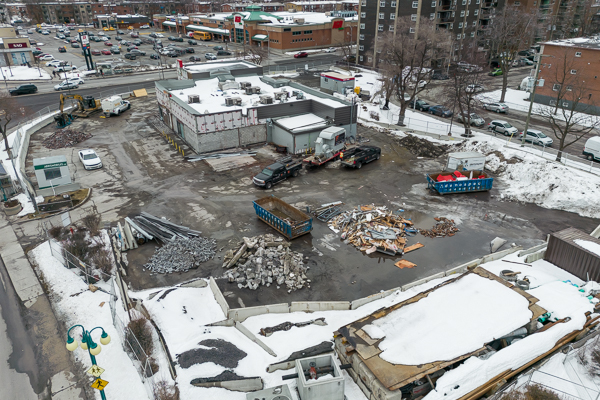
The old building at the Viau site was demolished in winter 2023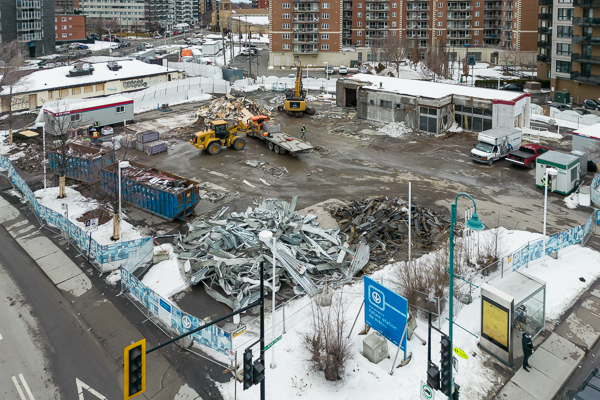
To facilitate recycling, selective materials triage is done on site during the deconstruction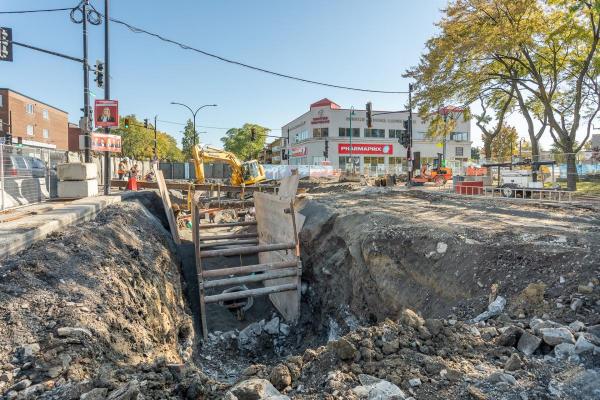
Preparatory work in the Lacordaire area
The blue line extension project follows in the wake of the Déclaration du gouvernement du Québec et de la Ville de Montréal to revitalize Montréal East. Many projects are underway to give a new impetus to this sector. Increased mobility, economic development, and improved living environments are at the heart of this ambitious project. For more information, see Québec.ca/RevitalisationEstMontreal (in French only).


